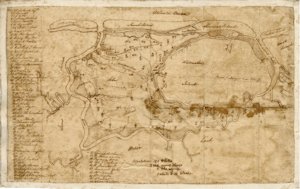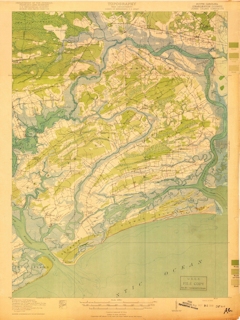
Click to enlarge
We recently acquired copies of two historic maps which will be displayed in the Johns Island Schoolhouse Museum. The first is a map done by Kinsey Burden in the 1820’s showing the ownership of major properties on Johns Island at that time. The map is particularly interesting because Mr. Burden owned two major plantations, Oakvale and Hut, and was the originator of the particular strain of high quality sea island cotton that was grown in the Lowcountry at that time (see The Story of Sea Island Cotton). The legend on the map shows the location of many plantation owners whose names are still common on these islands today; names such as Legare, Jenkins, Fripp, Freeman, Gibbes and Seabrook. The original of the map is in the Charleston Library Society’s collection.

Click to Enlarge
The second map is the 1919 US Geological Survey (USGS) topographical map done in cooperation with the “War Department” (today’s Department of Defense). USGS maps are available online from their website. These maps are done for the entire country on a grid system so that Johns Island, as a geographic entity, spans a few different maps. With some careful “cut & paste” we were able to cobble together a single map showing all of Johns Island on one sheet.
Both maps show a number of interesting historical developments especially for road names. In 1820, both River Road and Bohicket Road were simply “Public Road”. By 1919, today’s Bohicket Rd. was known as Inland Road and River Road had acquired its current name. However, up until the 1950’s River Road west of Edenvale and Appapoola Roads followed a more southerly course for a few miles along the creek. Today’s Maybank Highway was also know as Fenwick Road, presumably up until sometime after Charleston Mayor Maybank’s tenure. Both maps also show that there was a second bridge crossing from Wadmalaw to Johns Island, this one by the historic Presbyterian Church on Bohicket.

 Beauty and the Beast
Beauty and the Beast
Can copies of the Johns Island maps be purchase?